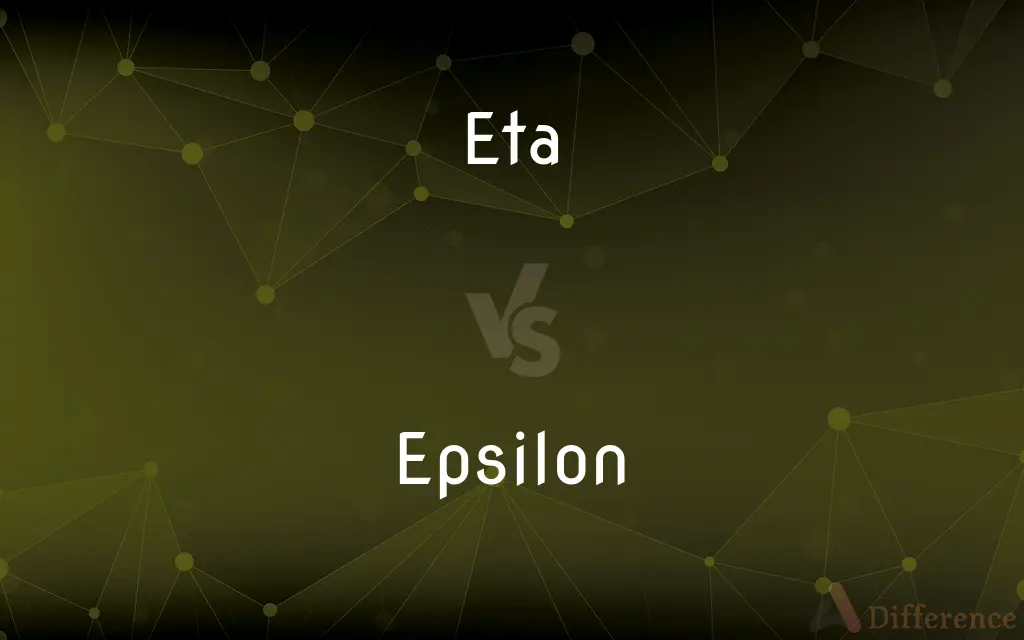Eta vs. Epsilon — What's the Difference?
By Urooj Arif & Maham Liaqat — Updated on March 22, 2024
Eta represents the 7th letter of the Greek alphabet, symbolizing a long "e" sound, while Epsilon is the 5th letter, representing a short "e" sound.

Difference Between Eta and Epsilon
Table of Contents
ADVERTISEMENT
Key Differences
Eta is the seventh letter of the Greek alphabet and is used in various scientific and mathematical contexts to represent different concepts, depending on the field. It represents a long "e" sound in Greek. On the other hand, Epsilon is the fifth letter of the Greek alphabet, representing a short "e" sound. It's widely used in mathematics, physics, and engineering to denote an arbitrarily small positive quantity, among other things.
In the Greek numeral system, Eta has a value of 8, highlighting its role beyond just a letter in the alphabet, serving also as a numeral in ancient times. Whereas, Epsilon represents the number 5 in the Greek numeral system, showcasing its numerical significance in addition to its alphabetical use.
Eta's appearance in uppercase is Η, and in lowercase is η, with its form changing significantly from uppercase to lowercase. This is contrasted by Epsilon, which is represented as Ε in uppercase and ε in lowercase, maintaining a more consistent shape between its two forms.
In scientific contexts, Eta is often used to represent efficiency, such as in thermodynamics, or viscosity in fluid dynamics, indicating its application in describing physical properties. Epsilon, on the other hand, is frequently used to denote strain in materials science, permittivity in electromagnetism, or to represent small quantities that approach zero in calculus, illustrating its broad applicability in precise measurements and theoretical constructs.
Despite their differences, both Eta and Epsilon are integral to the Greek alphabet and are used extensively across a wide range of academic and scientific disciplines, each carrying its unique set of meanings and applications.
ADVERTISEMENT
Comparison Chart
Greek Alphabet
7th letter
5th letter
Sound
Long "e"
Short "e"
Greek Numeral
8
5
Uppercase Form
Η
Ε
Lowercase Form
η
ε
Common Uses
Efficiency, viscosity
Strain, permittivity, small quantities
Compare with Definitions
Eta
Numerical Value.
As a Greek numeral, eta has a value of 8.
Epsilon
Sound Representation.
Epsilon represents a short e sound in Greek.
Eta
Scientific Use.
Eta is often used to symbolize efficiency in thermodynamics.
Epsilon
Greek Alphabet Position.
Epsilon is the fifth letter in the Greek alphabet.
Eta
Form.
The uppercase form of eta is Η, while its lowercase is η.
Epsilon
Scientific Use.
In mathematics, epsilon denotes an arbitrarily small positive quantity.
Eta
Sound Representation.
In Greek, eta represents a long e sound.
Epsilon
Numerical Value.
Epsilon's value in the Greek numeral system is 5.
Eta
Greek Alphabet Position.
Eta is the seventh letter in the Greek alphabet.
Epsilon
Form.
The uppercase form of epsilon is Ε, and the lowercase is ε.
Eta
Eta (uppercase Η, lowercase η; Ancient Greek: ἦτα ē̂ta [ɛ̂ːta] or Greek: ήτα ita [ˈita]) is the seventh letter of the Greek alphabet. Originally denoting the consonant /h/, its sound value in the classical Attic dialect of Ancient Greek was a long vowel [ɛː], raised to [i] in hellenistic Greek, a process known as iotacism.
Epsilon
Epsilon (UK: , US: ; uppercase Ε, lowercase ε or lunate ϵ; Greek: έψιλον) is the fifth letter of the Greek alphabet, corresponding phonetically to a mid front unrounded vowel /e/. In the system of Greek numerals it also has the value five.
Eta
The seventh letter of the Greek alphabet. See Table at alphabet.
Epsilon
The fifth letter of the Greek alphabet. See Table at alphabet.
Eta
The seventh letter of the Modern Greek alphabet, the eighth in Old Greek.
Epsilon
The name for the fifth letter of the Greek alphabet, ε or Ε, preceded by delta (Δ, δ) and followed by zeta (Ζ, ζ).
Eta
(particle) A kind of electrically neutral meson having zero spin and isospin.
Epsilon
(phonetics) In IPA, the phonetic symbol ɛ that represents the open-mid front unrounded vowel.
Eta
A social outcast in Japan who is subjected to menial work, making up a class or caste of such people.
Epsilon
(mathematics) An arbitrarily small quantity.
Eta
A terrorist organization organized in 1959 by student activists who were dissatisfied with the moderate nationalis of the traditional Basque party; want to create on independent homeland in Spain's western Pyrenees;
In 1968 ETA launched a campaign of political assassinations of government officials
Epsilon
(colloquial) A small child.
Eta
The 7th letter of the Greek alphabet
Epsilon
Something negligible or insignificant.
Yes, we have to convert all the symbol names to upper case at startup, but that’s epsilon.
Epsilon
(finance) The percentage change in an option value with respect to the underlying dividend yield.
Epsilon
The 5th letter of the Greek alphabet
Common Curiosities
What numerical value does Epsilon represent in Greek numerals?
Epsilon represents the number 5 in Greek numerals.
How are Eta and Epsilon used in scientific contexts?
Eta is often used to symbolize efficiency or viscosity, while Epsilon is used for strain, permittivity, or small quantities.
What numerical value does Eta represent in Greek numerals?
In Greek numerals, Eta represents the number 8.
Can Eta and Epsilon be used interchangeably?
No, they represent different sounds, values, and have distinct uses in various fields.
What is Eta?
Eta is the seventh letter of the Greek alphabet, representing a long "e" sound.
Why do Eta and Epsilon have different numerical values?
Their numerical values are based on their positions in the Greek numeral system, where each letter has a unique value.
What is the difference in sound between Eta and Epsilon?
Eta represents a long "e" sound, while Epsilon represents a short "e" sound.
What are some common applications of Eta in science?
Eta is used to represent efficiency in thermodynamics and viscosity in fluid dynamics.
What is Epsilon?
Epsilon is the fifth letter of the Greek alphabet, symbolizing a short "e" sound.
Can the scientific symbols for Eta and Epsilon vary by discipline?
Yes, their symbolic meanings can vary significantly across different scientific and mathematical disciplines.
How do the uppercase and lowercase forms of Eta and Epsilon differ?
Eta changes significantly from uppercase (Η) to lowercase (η), while Epsilon maintains a more consistent shape (Ε, ε).
Is there a historical reason for the distinct sounds of Eta and Epsilon?
Yes, their distinct sounds reflect the phonetic system of Ancient Greek, where each letter was assigned a specific vocal sound.
How do the uses of Eta and Epsilon reflect their importance in Greek culture?
Their uses in numerals, science, and mathematics reflect the Greek contributions to these fields and their alphabet's enduring legacy.
What are some common applications of Epsilon in mathematics and physics?
Epsilon denotes arbitrarily small quantities in calculus and permittivity in electromagnetism.
What is the significance of Eta's numerical value being higher than its position in the alphabet?
The discrepancy highlights the unique features of the Greek numeral system, where letters double as numbers.
Share Your Discovery

Previous Comparison
Picante vs. Piquant
Next Comparison
Hibiscus vs. SorrelAuthor Spotlight
Written by
Urooj ArifUrooj is a skilled content writer at Ask Difference, known for her exceptional ability to simplify complex topics into engaging and informative content. With a passion for research and a flair for clear, concise writing, she consistently delivers articles that resonate with our diverse audience.
Co-written by
Maham Liaqat













































